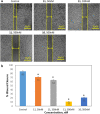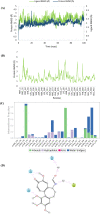Antiproliferative Potential of Gloriosine: A Lead for Anticancer Drug Development
- PMID: 36033689
- PMCID: PMC9404168
- DOI: 10.1021/acsomega.2c02688
Antiproliferative Potential of Gloriosine: A Lead for Anticancer Drug Development
Abstract
Gloriosine, a colchicine-like natural product, is widely obtained from Gloriosa superba roots. Despite having remarkable anticancer potential, colchicine could not pave its way to the clinic, while gloriosine is yet to be investigated for its pharmacological effects. In the present work, 14 compounds, including gloriosine, were isolated from the G. superba roots and were characterized by NMR spectroscopy. Gloriosine (11) was evaluated for its antiproliferative activity against a panel of 15 human cancer cell lines of different tissues and normal breast cells. Gloroisine (11) displayed significant antiproliferative activity against various cancer cell lines selectively, with IC50 values ranging from 32.61 to 100.28 nM. Further, gloriosine (11) was investigated for its apoptosis-inducing ability and found to form apoptotic bodies. It also inhibited A549 cell migration in the wound healing assay. Finally, molecular docking studies were performed to explore the possible binding modes of gloriosine with the colchicine-binding site of tubulin protein. Our findings suggested that gloriosine might be a potential lead for anticancer drug discovery.
© 2022 The Authors. Published by American Chemical Society.
Conflict of interest statement
The authors declare no competing financial interest.
Figures






Similar articles
-
Docking experiments suggest that gloriosine has microtubule-targeting properties similar to colchicine.Sci Rep. 2023 Mar 24;13(1):4854. doi: 10.1038/s41598-023-31187-6. Sci Rep. 2023. PMID: 36964265 Free PMC article.
-
High-performance Thin-layer Chromatographic-densitometric Quantification and Recovery of Bioactive Compounds for Identification of Elite Chemotypes of Gloriosa superba L. Collected from Sikkim Himalayas (India).Pharmacogn Mag. 2017 Oct;13(Suppl 3):S700-S705. doi: 10.4103/pm.pm_576_16. Epub 2017 Oct 11. Pharmacogn Mag. 2017. PMID: 29142436 Free PMC article.
-
Simultaneous Quantification of Pharmacologically Active Alkaloid Metabolites Colchicine and Gloriosine in Gloriosa Superba L. collected from Western Ghats (India) and Adjoining Areas for the Identification of Elite Chemotype(s).J AOAC Int. 2021 Aug 20;104(4):1155-1166. doi: 10.1093/jaoacint/qsab007. J AOAC Int. 2021. PMID: 33484241
-
Variability in alkaloid and phenolic content vis-a-vis antigout potential among the natural population of Gloriosa superba (L.) collected from Central India.Nat Prod Res. 2021 Jul;35(14):2444-2448. doi: 10.1080/14786419.2019.1675069. Epub 2019 Oct 14. Nat Prod Res. 2021. PMID: 31608665
-
Critical review on medicinally potent plant species: Gloriosa superba.Fitoterapia. 2011 Apr;82(3):293-301. doi: 10.1016/j.fitote.2010.11.008. Epub 2010 Nov 6. Fitoterapia. 2011. PMID: 21059382 Review.
Cited by
-
Docking experiments suggest that gloriosine has microtubule-targeting properties similar to colchicine.Sci Rep. 2023 Mar 24;13(1):4854. doi: 10.1038/s41598-023-31187-6. Sci Rep. 2023. PMID: 36964265 Free PMC article.
References
-
- Verma S.; Eikelboom J. W.; Nidorf S. M.; Al-Omran M.; Gupta N.; Teoh H.; Friedrich J. O. Colchicine in cardiac disease: a systematic review and meta-analysis of randomized controlled trials. BMC Cardiovasc. Disord. 2015, 15, 9610.1186/s12872-015-0068-3. - DOI - PMC - PubMed
- Deftereos S.; Giannopoulos G.; Papoutsidakis N.; Panagopoulou V.; Kossyvakis C.; Raisakis K.; Cleman M. W.; Stefanadis C. Colchicine and the Heart: Pushing the Envelope. J. Am. Coll. Cardiol. 2013, 62, 1817–1825. 10.1016/j.jacc.2013.08.726. - DOI - PubMed
-
- Hagras M.; El Deeb M. A.; Elzahabi H. S. A.; Elkaeed E. B.; Mehany A. B. M.; Eissa I. H. Discovery of new quinolines as potent colchicine binding site inhibitors: design, synthesis, docking studies, and anti-proliferative evaluation. J. Enzyme Inhib. Med. Chem. 2021, 36, 640–658. 10.1080/14756366.2021.1883598. - DOI - PMC - PubMed
-
- Eissa I. H.; Dahab M. A.; Ibrahim M. K.; Alsaif N. A.; Alanazi A. Z.; Eissa S. I.; Mehany A. B. M.; Beauchemin A. M. Design and discovery of new antiproliferative 1,2,4-triazin-3(2H)-ones as tubulin polymerization inhibitors targeting colchicine binding site. Bioorg. Chem. 2021, 112, 10496510.1016/j.bioorg.2021.104965. - DOI - PubMed
- El-Naggar A. M.; Eissa I. H.; Belal A.; El-Sayed A. A. Design, eco-friendly synthesis, molecular modeling and anticancer evaluation of thiazol-5(4H)-ones as potential tubulin polymerization inhibitors targeting the colchicine binding site. RSC Adv. 2020, 10, 2791–2811. 10.1039/C9RA10094F. - DOI - PMC - PubMed
LinkOut - more resources
Full Text Sources

